While I typically write forward-looking commentary and analysis, I wanted to write a piece that showed the anatomy of a trade in 5 simple steps, essentially tying together all the various aspects of the education that I teach. Here’s more…
A trader friend recently took my Swing Trade Pro course – and loved it! As a matter of fact, he gave me perhaps the best testimonial I could’ve gotten for the course – “Frank, this is really good sh*t!” (Hi Tom!)
He told me about a great trade he had taken in Taser International ($TASR), and asked me to take a look. After checking it out, I thought it would be a great idea to share with you how my approach played out in this stock – in 5 simple steps.
Step 1: Identify the Setup
In the daily chart of TASR, you see a very distinct pattern that had formed – the Inside Day pattern. This pattern is a favorite among swing traders because it has the ability to spark some of the best breakouts in the market.
The key to this setup is to be patient and wait for the right “opening relationship”. That is, just because an Inside Day pattern has formed doesn’t mean automatic profits. You have to wait for price to break out from the pattern in a manner that provides the best odds for success.
In this case, price opened the next session with a gap up, out of range and out of value. This is the most bullish opening relationship you could ask for. Any time price gaps out of the prior day’s price range, this is a clear indication that market sentiment has shifted overnight and initiative participants are eager to begin pushing price to new value.
Now that we have a great setup with a great opening relationship, let’s move to Step 2.
Step 2: Identify the Entry
There are many ways to enter a trade. I teach 3 primary techniques for executing entries, along with many hybrids for identifying trade location – easily totaling 10 or more methods that I use interchangeably given the specific scenario.
In this trade example, I’ll identify three ways that I teach to enter a trade.
1. Retest Entry: When the market gaps out of range and value, I watch the first 15-minute bar of the day to see how it responds after the gap. If price maintains gap integrity and closes bullishly, then I set a Buy Limit order at the center of the 15-minute candlestick. In this case, the Buy Limit is set to $7.30, which would have triggered during four of the next five 15-minute bars.
This method gets you into the trade 2 ticks from the low after you set the entry. Not bad.
2. OR-30 Breakout: If you happen to miss the Retest Entry, it’s then time to try for a 30-minute Opening Range breakout entry. The idea here is to Buy a breakout from the opening 30-minute range, which is done by setting a Stop Market order to Buy a tick or two above the 30-minute opening high price. This technique gets you into the trade at $7.36.
3. OR-30 Bounce: If you happen to miss the entries for both the Retest and OR Breakout techniques, don’t fret. Instead, use the OR-30 Bounce technique. Place an Ambush Buy Limit back at the opening range high price at $7.35 and wait to be filled.
Oftentimes, price will return to retest a breakout level before resuming in the original direction. When this occurs, the traders that were left behind will now board the train in this zone, thereby adding additional fuel to the up move.
This technique gets you into the trade at $7.35
Step 3: Identify the Trade Management
Here’s the deal, a properly outlined trade management approach is a MUST. You must know EXACTLY what you will do when you trigger a trade. Will you use profit targets? How about trailing stops? How are you calculating your fixed loss stop? Are you scaling out of the trade? These questions and more must be answered BEFORE you enter a trade.
As a professional trader, you must have a toolkit that includes all the various approaches that you have at your disposal. All you have to decide is which to use for this specific trade. The trade will dictate your approach.
Let’s start with the stop. I’m a fan of using Average Daily Range (ADR) in my trading – for both stops and targets. For stops, it’s as easy as calculating the average daily range over the last 10 periods, and then cutting that value in half. This is your stop amount.
For TASR, the 10-day ADR was $0.57 on the day of the setup (Feb 27), which means TASR moves 57 ticks per day on average. Cutting this value in half gives us a stop amount of $0.28, which is half the daily range.
For targets, you can use a variety of approaches. I like to trade to profit targets because I can calculate targets with a high degree of accuracy using my ADR Method (RT Edition and SWING Edition).
For a standard swing trade, I’ll calculate a 5-day ADR target. In the case of TASR, the average 5-day MDR (Multiple Day Range) on the day of the setup was $1.405, which means during the most recent period of time, TASR moved on average $1.40 every 5 days.
Since price doesn’t always move in exact averages (if ever), I like to use 75% of the average MDR, which is $1.05. Therefore, we project $1.05 higher from the prior day’s low price of $6.93 in order to get our 5-day profit target of $7.98.
We’ll play to this target.
Step 4: Execute the Trade
Here’s the fun part. You’ve identified the setup, identified the entry techniques that you can use for this particular setup, and you’ve already identified the stop and profit target that you’ll use.
All that’s left is to execute your plan. Plan the trade; trade the plan.
This is when you must approach trading without emotion; like a machine. You are just executing a plan. That’s all. Nothing more, nothing less.
By approaching trading in this manner, you are virtually eliminating emotion. Furthermore, you are approaching trading like a business and merely executing the task at hand.
Step 5: Sit on Your Hands
Once you’ve triggered your entry, and set your stop and profit target…DON’T TOUCH ANYTHING! Once money is on the line, clear thinking happens to go out the window. That’s why you plan the trade ahead of time when you are thinking at your clearest.
Any tinkering with the trade that this point is a recipe for a botched trade.
The Final Tally
As it turns out, the profit target of $7.98 was reached in exactly 5 days, giving you a solid trade with great trade location, well-defined risk, and a high-probability target. Not bad for 5 days of “work”.
Here’s how the trade turned out using the 3 different entry methods:
Retest Entry: Entry – $7.30, Stop – $7.02, Target – $7.98, Gain of +9.3%
OR Breakout: Entry – $7.36, Stop – $7.08, Target – $7.98, Gain of +8.4%
OR Bounce: Entry – $7.35, Stop – $7.07, Target – $7.98, Gain of +8.5%
While every trade in the market is different, having a proven method for attacking the market is a must. Every method and technique used above is one of a series of techniques, concepts, and methods that I teach at PivotBoss.
If you liked this post, let me know in the comments section below. If there’s enough interest, I’ll make this type of post a regular at PivotBoss.com.
Cheers!
Frank Ochoa
PivotBoss | Own the Market
Follow us on Twitter: http://twitter.com/PivotBoss


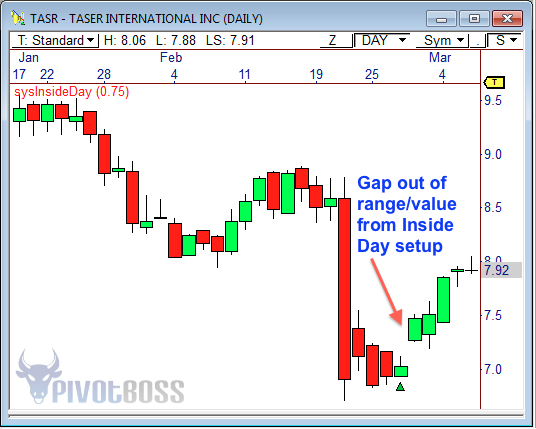
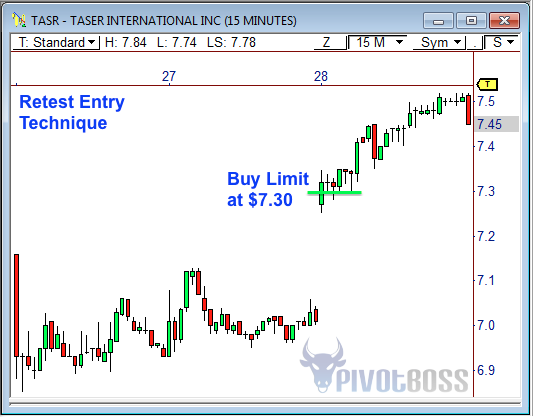
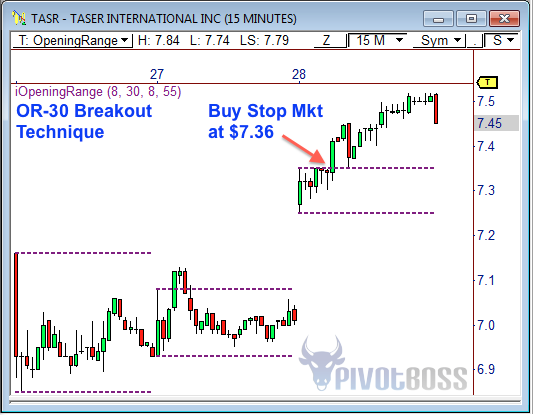
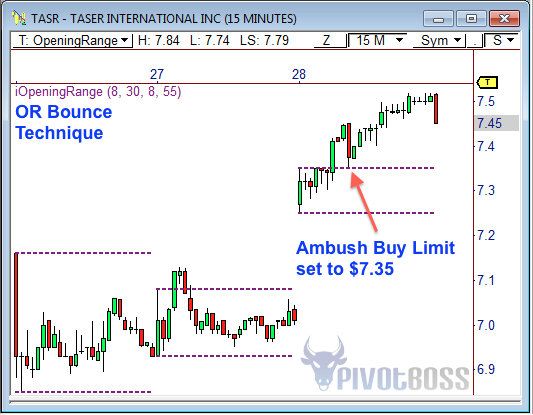

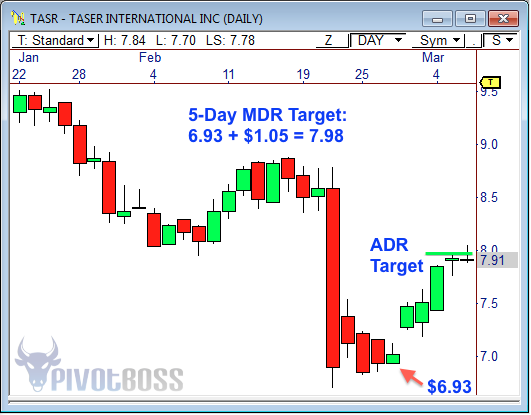
Frank
great analysis and walk-thru of the trade-really helps
Thanks, Barney! I’m glad you enjoyed it. Takes a little time to write a piece like that, but I’ll definitely do it more often if there’s interest.
Frank
Great Write up, thanks Frank.. use the ADR every day, Iam getting 80% avg daily wins on the ES, thanks